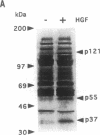Abstract
T-cell migration into tissue depends on a cascade of rapid and selective adhesive interactions with endothelium. "Triggering" is a step in that cascade required to activate T-cell integrins. Hepatocyte growth factor (HGF) may be a physiologically relevant trigger, since we demonstrate that HGF can induce both adhesion and migration of human T-cell subsets and can be detected immunohistochemically on inflamed endothelium. HGF preferentially induces responses from T cells of memory phenotype, in contrast to macrophage inflammatory protein 1 beta (MIP-1 beta), a chemokine which acts preferentially on naive cells. HGF, like the chemokines, binds to heparin, and HGF retained in extracellular matrix is efficient in promoting migration. Further, both MIP-1 beta and HGF induce actin polymerization within seconds, kinetics that approach those required to contribute to physiologic triggering. HGF is a member of a structural family distinct from the chemokines, whose only known receptor is the tyrosine kinase c-Met. HGF induces tyrosine phosphorylation on T cells apparently via a distinct receptor, since no c-Met is detectable by surface staining, PCR, or anti-phosphotyrosine immunoprecipitation. Thus, promotion of T-cell adhesion and migration are previously undescribed functions of HGF that we propose are relevant to selective T-cell recruitment.
Full text
PDF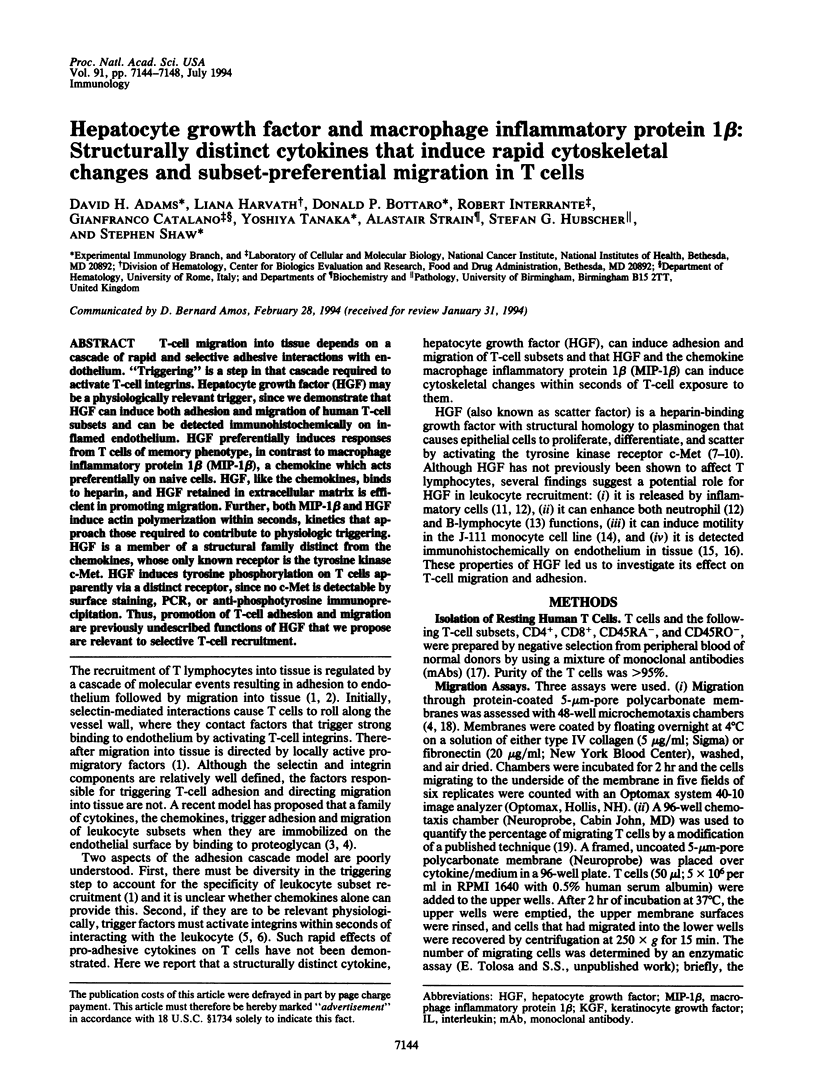
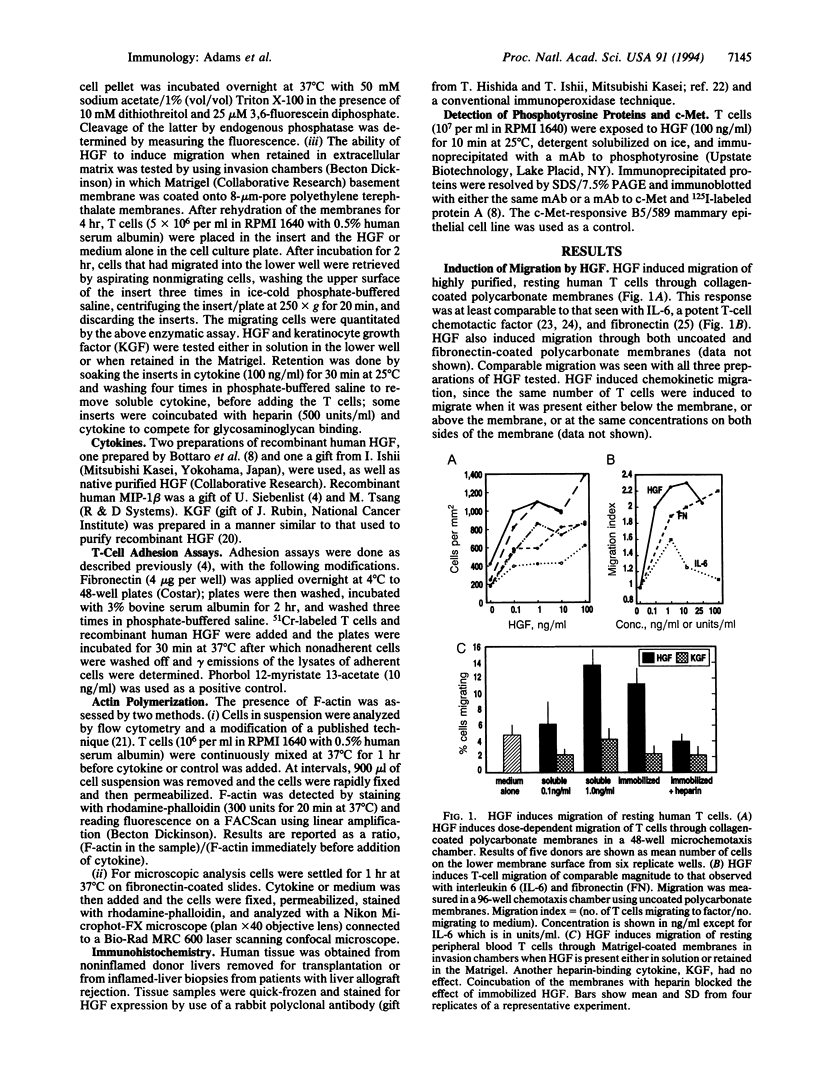

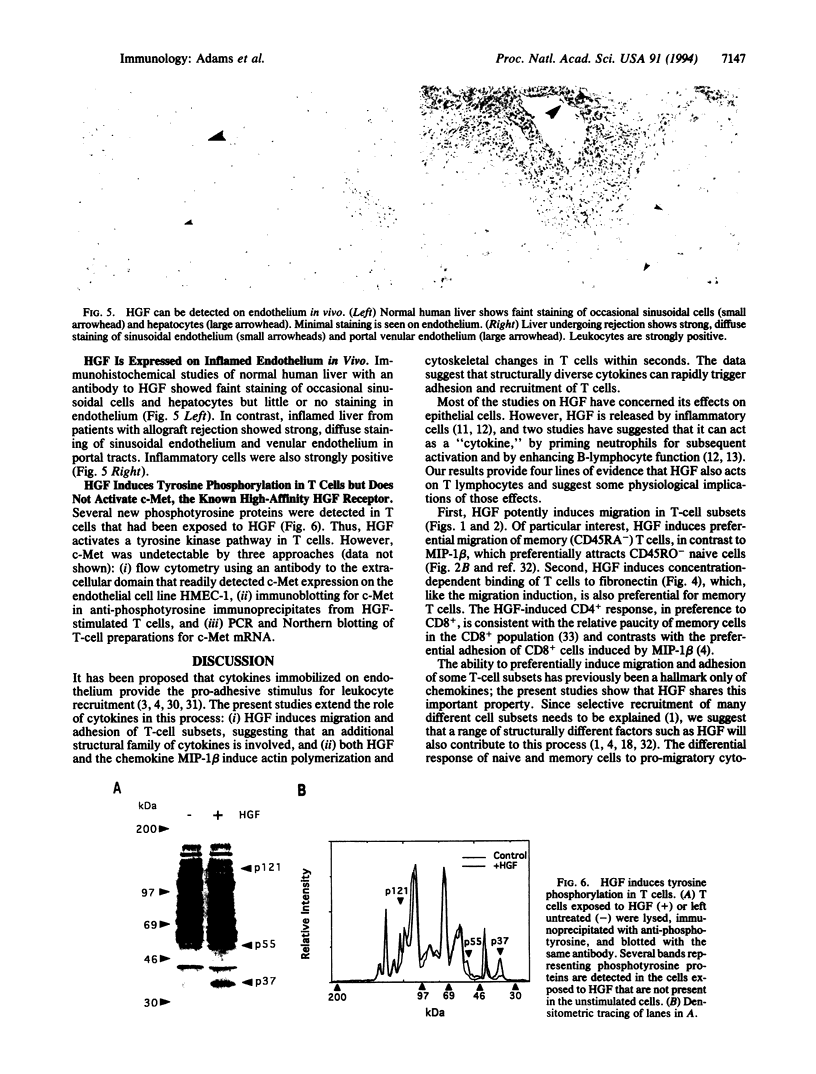
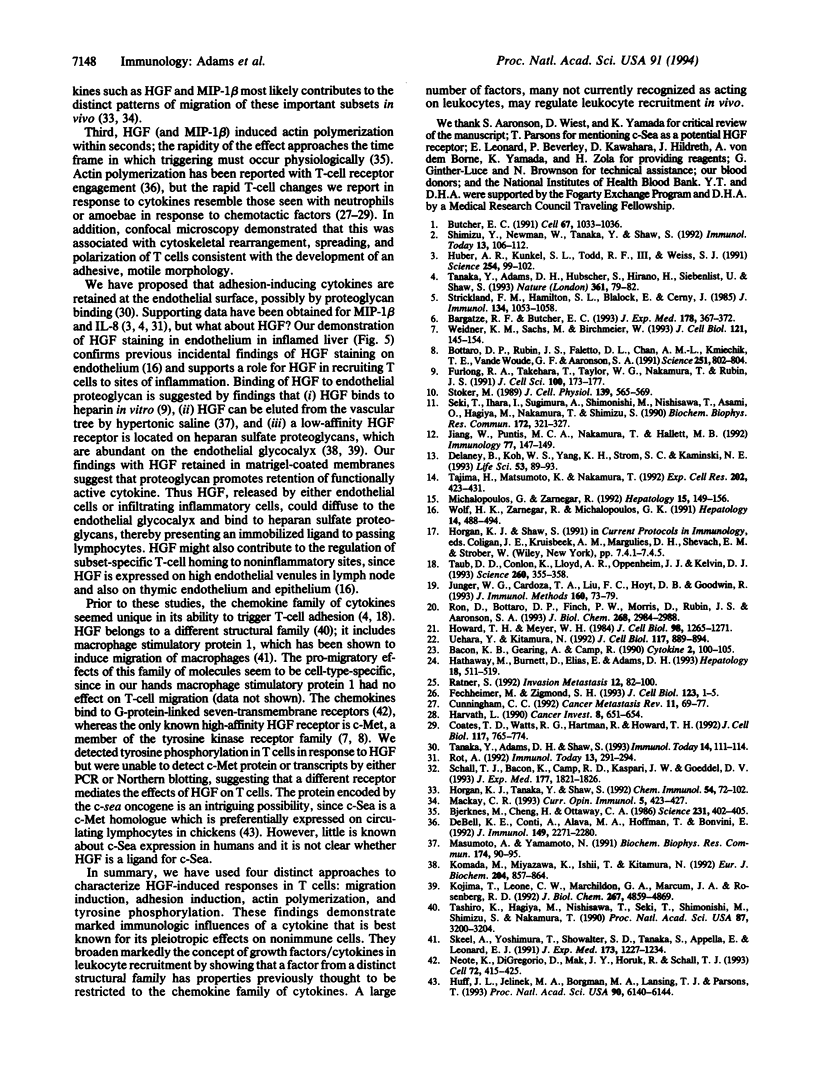
Images in this article
Selected References
These references are in PubMed. This may not be the complete list of references from this article.
- Bacon K., Gearing A., Camp R. Induction of in vitro human lymphocyte migration by interleukin 3, interleukin 4, and interleukin 6. Cytokine. 1990 Mar;2(2):100–105. doi: 10.1016/1043-4666(90)90003-c. [DOI] [PubMed] [Google Scholar]
- Bargatze R. F., Butcher E. C. Rapid G protein-regulated activation event involved in lymphocyte binding to high endothelial venules. J Exp Med. 1993 Jul 1;178(1):367–372. doi: 10.1084/jem.178.1.367. [DOI] [PMC free article] [PubMed] [Google Scholar]
- Bjerknes M., Cheng H., Ottaway C. A. Dynamics of lymphocyte-endothelial interactions in vivo. Science. 1986 Jan 24;231(4736):402–405. doi: 10.1126/science.3941903. [DOI] [PubMed] [Google Scholar]
- Bottaro D. P., Rubin J. S., Faletto D. L., Chan A. M., Kmiecik T. E., Vande Woude G. F., Aaronson S. A. Identification of the hepatocyte growth factor receptor as the c-met proto-oncogene product. Science. 1991 Feb 15;251(4995):802–804. doi: 10.1126/science.1846706. [DOI] [PubMed] [Google Scholar]
- Butcher E. C. Leukocyte-endothelial cell recognition: three (or more) steps to specificity and diversity. Cell. 1991 Dec 20;67(6):1033–1036. doi: 10.1016/0092-8674(91)90279-8. [DOI] [PubMed] [Google Scholar]
- Coates T. D., Watts R. G., Hartman R., Howard T. H. Relationship of F-actin distribution to development of polar shape in human polymorphonuclear neutrophils. J Cell Biol. 1992 May;117(4):765–774. doi: 10.1083/jcb.117.4.765. [DOI] [PMC free article] [PubMed] [Google Scholar]
- DeBell K. E., Conti A., Alava M. A., Hoffman T., Bonvini E. Microfilament assembly modulates phospholipase C-mediated signal transduction by the TCR/CD3 in murine T helper lymphocytes. J Immunol. 1992 Oct 1;149(7):2271–2280. [PubMed] [Google Scholar]
- Fechheimer M., Zigmond S. H. Focusing on unpolymerized actin. J Cell Biol. 1993 Oct;123(1):1–5. doi: 10.1083/jcb.123.1.1. [DOI] [PMC free article] [PubMed] [Google Scholar]
- Furlong R. A., Takehara T., Taylor W. G., Nakamura T., Rubin J. S. Comparison of biological and immunochemical properties indicates that scatter factor and hepatocyte growth factor are indistinguishable. J Cell Sci. 1991 Sep;100(Pt 1):173–177. doi: 10.1242/jcs.100.1.173. [DOI] [PubMed] [Google Scholar]
- Harvath L. Regulation of neutrophil chemotaxis: correlations with actin polymerization. Cancer Invest. 1990;8(6):651–654. doi: 10.3109/07357909009018937. [DOI] [PubMed] [Google Scholar]
- Hathaway M., Burnett D., Elias E., Adams D. H. Secretion of soluble chemotactic factors, including interleukin-6: a mechanism for the recruitment of CD8-positive T lymphocytes to human liver allografts during rejection. Hepatology. 1993 Sep;18(3):511–518. [PubMed] [Google Scholar]
- Horgan K. J., Tanaka Y., Shaw S. Postthymic differentiation of CD4 T lymphocytes: naive versus memory subsets and further specialization among memory cells. Chem Immunol. 1992;54:72–102. [PubMed] [Google Scholar]
- Howard T. H., Meyer W. H. Chemotactic peptide modulation of actin assembly and locomotion in neutrophils. J Cell Biol. 1984 Apr;98(4):1265–1271. doi: 10.1083/jcb.98.4.1265. [DOI] [PMC free article] [PubMed] [Google Scholar]
- Huber A. R., Kunkel S. L., Todd R. F., 3rd, Weiss S. J. Regulation of transendothelial neutrophil migration by endogenous interleukin-8. Science. 1991 Oct 4;254(5028):99–102. doi: 10.1126/science.1718038. [DOI] [PubMed] [Google Scholar]
- Huff J. L., Jelinek M. A., Borgman C. A., Lansing T. J., Parsons J. T. The protooncogene c-sea encodes a transmembrane protein-tyrosine kinase related to the Met/hepatocyte growth factor/scatter factor receptor. Proc Natl Acad Sci U S A. 1993 Jul 1;90(13):6140–6144. doi: 10.1073/pnas.90.13.6140. [DOI] [PMC free article] [PubMed] [Google Scholar]
- Jiang W., Puntis M. C., Nakamura T., Hallett M. B. Neutrophil priming by hepatocyte growth factor, a novel cytokine. Immunology. 1992 Sep;77(1):147–149. [PMC free article] [PubMed] [Google Scholar]
- Junger W. G., Cardoza T. A., Liu F. C., Hoyt D. B., Goodwin R. Improved rapid photometric assay for quantitative measurement of PMN migration. J Immunol Methods. 1993 Mar 15;160(1):73–79. doi: 10.1016/0022-1759(93)90010-5. [DOI] [PubMed] [Google Scholar]
- Kojima T., Leone C. W., Marchildon G. A., Marcum J. A., Rosenberg R. D. Isolation and characterization of heparan sulfate proteoglycans produced by cloned rat microvascular endothelial cells. J Biol Chem. 1992 Mar 5;267(7):4859–4869. [PubMed] [Google Scholar]
- Komada M., Miyazawa K., Ishii T., Kitamura N. Characterization of hepatocyte-growth-factor receptors on Meth A cells. Eur J Biochem. 1992 Mar 1;204(2):857–864. doi: 10.1111/j.1432-1033.1992.tb16705.x. [DOI] [PubMed] [Google Scholar]
- Mackay C. R. Homing of naive, memory and effector lymphocytes. Curr Opin Immunol. 1993 Jun;5(3):423–427. doi: 10.1016/0952-7915(93)90063-x. [DOI] [PubMed] [Google Scholar]
- Masumoto A., Yamamoto N. Sequestration of a hepatocyte growth factor in extracellular matrix in normal adult rat liver. Biochem Biophys Res Commun. 1991 Jan 15;174(1):90–95. doi: 10.1016/0006-291x(91)90489-t. [DOI] [PubMed] [Google Scholar]
- Michalopoulos G. K., Zarnegav R. Hepatocyte growth factor. Hepatology. 1992 Jan;15(1):149–155. doi: 10.1002/hep.1840150125. [DOI] [PubMed] [Google Scholar]
- Neote K., DiGregorio D., Mak J. Y., Horuk R., Schall T. J. Molecular cloning, functional expression, and signaling characteristics of a C-C chemokine receptor. Cell. 1993 Feb 12;72(3):415–425. doi: 10.1016/0092-8674(93)90118-a. [DOI] [PubMed] [Google Scholar]
- Ratner S. Lymphocyte migration through extracellular matrix. Invasion Metastasis. 1992;12(2):82–100. [PubMed] [Google Scholar]
- Ron D., Bottaro D. P., Finch P. W., Morris D., Rubin J. S., Aaronson S. A. Expression of biologically active recombinant keratinocyte growth factor. Structure/function analysis of amino-terminal truncation mutants. J Biol Chem. 1993 Feb 5;268(4):2984–2988. [PubMed] [Google Scholar]
- Rot A. Endothelial cell binding of NAP-1/IL-8: role in neutrophil emigration. Immunol Today. 1992 Aug;13(8):291–294. doi: 10.1016/0167-5699(92)90039-A. [DOI] [PubMed] [Google Scholar]
- Schall T. J., Bacon K., Camp R. D., Kaspari J. W., Goeddel D. V. Human macrophage inflammatory protein alpha (MIP-1 alpha) and MIP-1 beta chemokines attract distinct populations of lymphocytes. J Exp Med. 1993 Jun 1;177(6):1821–1826. doi: 10.1084/jem.177.6.1821. [DOI] [PMC free article] [PubMed] [Google Scholar]
- Seki T., Ihara I., Sugimura A., Shimonishi M., Nishizawa T., Asami O., Hagiya M., Nakamura T., Shimizu S. Isolation and expression of cDNA for different forms of hepatocyte growth factor from human leukocyte. Biochem Biophys Res Commun. 1990 Oct 15;172(1):321–327. doi: 10.1016/s0006-291x(05)80212-8. [DOI] [PubMed] [Google Scholar]
- Shimizu Y., Newman W., Tanaka Y., Shaw S. Lymphocyte interactions with endothelial cells. Immunol Today. 1992 Mar;13(3):106–112. doi: 10.1016/0167-5699(92)90151-V. [DOI] [PubMed] [Google Scholar]
- Skeel A., Yoshimura T., Showalter S. D., Tanaka S., Appella E., Leonard E. J. Macrophage stimulating protein: purification, partial amino acid sequence, and cellular activity. J Exp Med. 1991 May 1;173(5):1227–1234. doi: 10.1084/jem.173.5.1227. [DOI] [PMC free article] [PubMed] [Google Scholar]
- Stoker M. Effect of scatter factor on motility of epithelial cells and fibroblasts. J Cell Physiol. 1989 Jun;139(3):565–569. doi: 10.1002/jcp.1041390316. [DOI] [PubMed] [Google Scholar]
- Strickland F. M., Hamilton S. L., Blalock E., Cerny J. Shared idiotypy between phosphorylcholine-specific antibody and acetylcholinesterase detectable by a monoclonal antibody. J Immunol. 1985 Feb;134(2):1053–1058. [PubMed] [Google Scholar]
- Tajima H., Matsumoto K., Nakamura T. Regulation of cell growth and motility by hepatocyte growth factor and receptor expression in various cell species. Exp Cell Res. 1992 Oct;202(2):423–431. doi: 10.1016/0014-4827(92)90095-p. [DOI] [PubMed] [Google Scholar]
- Tanaka Y., Adams D. H., Hubscher S., Hirano H., Siebenlist U., Shaw S. T-cell adhesion induced by proteoglycan-immobilized cytokine MIP-1 beta. Nature. 1993 Jan 7;361(6407):79–82. doi: 10.1038/361079a0. [DOI] [PubMed] [Google Scholar]
- Tanaka Y., Adams D. H., Shaw S. Proteoglycans on endothelial cells present adhesion-inducing cytokines to leukocytes. Immunol Today. 1993 Mar;14(3):111–115. doi: 10.1016/0167-5699(93)90209-4. [DOI] [PubMed] [Google Scholar]
- Tashiro K., Hagiya M., Nishizawa T., Seki T., Shimonishi M., Shimizu S., Nakamura T. Deduced primary structure of rat hepatocyte growth factor and expression of the mRNA in rat tissues. Proc Natl Acad Sci U S A. 1990 Apr;87(8):3200–3204. doi: 10.1073/pnas.87.8.3200. [DOI] [PMC free article] [PubMed] [Google Scholar]
- Taub D. D., Conlon K., Lloyd A. R., Oppenheim J. J., Kelvin D. J. Preferential migration of activated CD4+ and CD8+ T cells in response to MIP-1 alpha and MIP-1 beta. Science. 1993 Apr 16;260(5106):355–358. doi: 10.1126/science.7682337. [DOI] [PubMed] [Google Scholar]
- Uehara Y., Kitamura N. Expression of a human hepatocyte growth factor/scatter factor cDNA in MDCK epithelial cells influences cell morphology, motility, and anchorage-independent growth. J Cell Biol. 1992 May;117(4):889–894. doi: 10.1083/jcb.117.4.889. [DOI] [PMC free article] [PubMed] [Google Scholar]
- Weidner K. M., Sachs M., Birchmeier W. The Met receptor tyrosine kinase transduces motility, proliferation, and morphogenic signals of scatter factor/hepatocyte growth factor in epithelial cells. J Cell Biol. 1993 Apr;121(1):145–154. doi: 10.1083/jcb.121.1.145. [DOI] [PMC free article] [PubMed] [Google Scholar]
- Wolf H. K., Zarnegar R., Michalopoulos G. K. Localization of hepatocyte growth factor in human and rat tissues: an immunohistochemical study. Hepatology. 1991 Sep;14(3):488–494. [PubMed] [Google Scholar]





